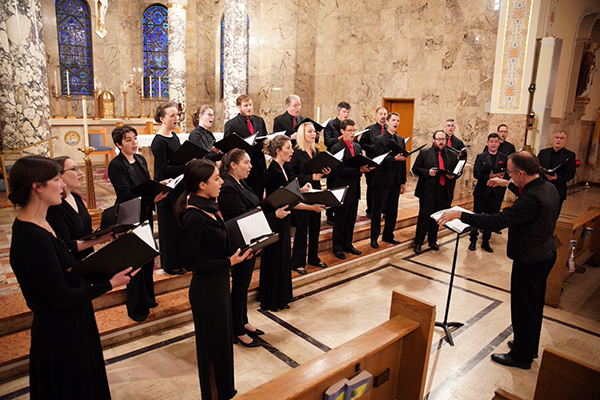by Daniel Hathaway

“My spouse and I were visiting a friend who is an early musician in Texas,” White said in a recent telephone conversation. “He and his partner, who passed away recently, had collected hundreds of recordings during their 60 years together, and he was painstakingly going through them to see what he wanted to keep. The three of us were able to whittle it down quite a bit, but we had to look at every single recording, because there were some real treasures.
“I looked at this one recording and said, ‘Wait a minute. A St. John Passion I’ve never heard of before?’ About a month later, I found the score and decided that Quire needed to perform it.”
Perform it they will, at free concerts in three historic Catholic churches whose parishes were created in the last years of the 19th century by immigrants from Eastern Europe: St. John Cantius, established by Poles (Friday, March 4), St. Vitus, founded by Slovenians (Saturday, March 5), and St. Elizabeth of Hungary, organized by Hungarians (Sunday, March 6).
Christoph Demantius, who lived from 1547 to 1643, was an exact contemporary of Claudio Monteverdi. A prolific composer, most of whose works have gone missing, he was active in Leipzig, served as Kantor in Zittau, and ended his career at Freiburg Cathedral during the Thirty Years War. His setting of the Passion story from the Gospel of John is regarded as the culmination of the Renaissance “Motet Passion,” before passion settings adopted a new, more dramatic Baroque style — like Bach’s Johannes-Passion.
White admitted that his first pass through the score was cursory. “I didn’t really look at the whole thing from front to back and thought that it was going to be a 35-minute piece — which it wasn’t.
“So our plans spiraled and we started adding to the program. First, the Weissagung, a companion piece by Demantius that sets more cerebral Passion prophecies from the Book of Isaiah. Then we added two Demantius motets, and chorales from Bach’s St. John Passion at appropriate points in the story. The whole program as it stands now lasts just under an hour.”
Bach’s setting is famous for its intense presentation of the story using the theatrical tools of the late Baroque period — narrative recitatives, reflective arias, and evocative crowd choruses. In his program notes for Quire’s concerts, White gives some advice to the audience about how to appreciate the drama and pathos of the Passion story as told in Demantius’ more madrigalian musical style.
In each motet, the Passion, and the Prophecy, I advise you to closely follow the translations provided. Renaissance composers took great interest in choosing specific figures that would paint or color the texts they were setting. Pay attention to whether he uses higher voices for younger characters or lower voices representing a group of men. Notice how he chooses to highlight the mention of an animal, a physical gesture, or a particular human emotion. Immerse yourselves in the shifts in sonorities and textures as Quire gives voice to these treasures.
Listeners can also prepare themselves for this weekend’s experience by sampling two YouTube videos that White recommends, made by Rotterdam’s Laurens Collegium one year ago. Click here to access their performance of the Johannes-Passion, and here to experience the Weissagung, Demantius’ companion setting of the 53rd Chapter of the Book of Isaiah.
Quire’s concerts are free (donations welcome), and masks are required. Here’s the schedule:
Friday, March 4 at 7:30 pm, St. John Cantius Church, 906 College Ave.
Saturday, March 5 at 5:30 pm, St. Vitus Church, 6019 Lausche Ave.
Sunday, March 6 at 4:00 pm, St. Elizabeth of Hungary Church, 9016 Buckeye Rd.
Download the program book with texts and translations here, and learn more about the history of these three historic churches here.
Published on ClevelandClassical.com March 3, 2022.
Click here for a printable copy of this article




